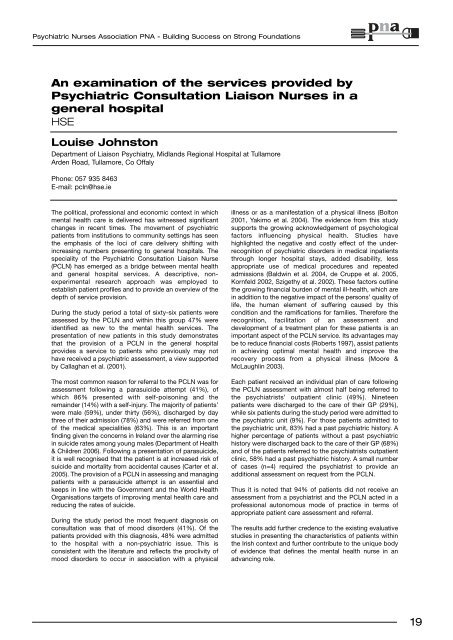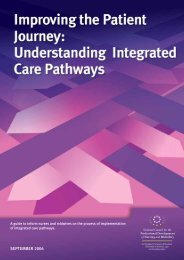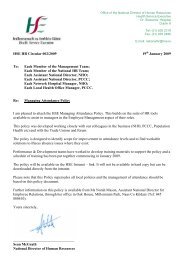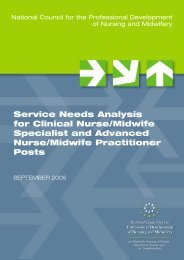Building Success on Strong Foundations - PNA
Building Success on Strong Foundations - PNA
Building Success on Strong Foundations - PNA
- No tags were found...
You also want an ePaper? Increase the reach of your titles
YUMPU automatically turns print PDFs into web optimized ePapers that Google loves.
Psychiatric Nurses Associati<strong>on</strong> <strong>PNA</strong> - <str<strong>on</strong>g>Building</str<strong>on</strong>g> <str<strong>on</strong>g>Success</str<strong>on</strong>g> <strong>on</strong> Str<strong>on</strong>g Foundati<strong>on</strong>sAn examinati<strong>on</strong> of the services provided byPsychiatric C<strong>on</strong>sultati<strong>on</strong> Liais<strong>on</strong> Nurses in ageneral hospitalHSELouise Johnst<strong>on</strong>Department of Liais<strong>on</strong> Psychiatry, Midlands Regi<strong>on</strong>al Hospital at TullamoreArden Road, Tullamore, Co OffalyPh<strong>on</strong>e: 057 935 8463E-mail: pcln@hse.ieThe political, professi<strong>on</strong>al and ec<strong>on</strong>omic c<strong>on</strong>text in whichmental health care is delivered has witnessed significantchanges in recent times. The movement of psychiatricpatients from instituti<strong>on</strong>s to community settings has seenthe emphasis of the loci of care delivery shifting withincreasing numbers presenting to general hospitals. Thespeciality of the Psychiatric C<strong>on</strong>sultati<strong>on</strong> Liais<strong>on</strong> Nurse(PCLN) has emerged as a bridge between mental healthand general hospital services. A descriptive, n<strong>on</strong>experimentalresearch approach was employed toestablish patient profiles and to provide an overview of thedepth of service provisi<strong>on</strong>.During the study period a total of sixty-six patients wereassessed by the PCLN and within this group 47% wereidentified as new to the mental health services. Thepresentati<strong>on</strong> of new patients in this study dem<strong>on</strong>stratesthat the provisi<strong>on</strong> of a PCLN in the general hospitalprovides a service to patients who previously may nothave received a psychiatric assessment, a view supportedby Callaghan et al. (2001).The most comm<strong>on</strong> reas<strong>on</strong> for referral to the PCLN was forassessment following a parasuicide attempt (41%), ofwhich 86% presented with self-pois<strong>on</strong>ing and theremainder (14%) with a self-injury. The majority of patients’were male (59%), under thirty (56%), discharged by daythree of their admissi<strong>on</strong> (78%) and were referred from <strong>on</strong>eof the medical specialities (63%). This is an importantfinding given the c<strong>on</strong>cerns in Ireland over the alarming risein suicide rates am<strong>on</strong>g young males (Department of Health& Children 2006). Following a presentati<strong>on</strong> of parasuicide,it is well recognised that the patient is at increased risk ofsuicide and mortality from accidental causes (Carter et al.2005). The provisi<strong>on</strong> of a PCLN in assessing and managingpatients with a parasuicide attempt is an essential andkeeps in line with the Government and the World HealthOrganisati<strong>on</strong>s targets of improving mental health care andreducing the rates of suicide.During the study period the most frequent diagnosis <strong>on</strong>c<strong>on</strong>sultati<strong>on</strong> was that of mood disorders (41%). Of thepatients provided with this diagnosis, 48% were admittedto the hospital with a n<strong>on</strong>-psychiatric issue. This isc<strong>on</strong>sistent with the literature and reflects the proclivity ofmood disorders to occur in associati<strong>on</strong> with a physicalillness or as a manifestati<strong>on</strong> of a physical illness (Bolt<strong>on</strong>2001, Yakimo et al. 2004). The evidence from this studysupports the growing acknowledgement of psychologicalfactors influencing physical health. Studies havehighlighted the negative and costly effect of the underrecogniti<strong>on</strong>of psychiatric disorders in medical inpatientsthrough l<strong>on</strong>ger hospital stays, added disability, lessappropriate use of medical procedures and repeatedadmissi<strong>on</strong>s (Baldwin et al. 2004, de Cruppe et al. 2005,Kornfeld 2002, Szigethy et al. 2002). These factors outlinethe growing financial burden of mental ill-health, which arein additi<strong>on</strong> to the negative impact of the pers<strong>on</strong>s’ quality oflife, the human element of suffering caused by thisc<strong>on</strong>diti<strong>on</strong> and the ramificati<strong>on</strong>s for families. Therefore therecogniti<strong>on</strong>, facilitati<strong>on</strong> of an assessment anddevelopment of a treatment plan for these patients is animportant aspect of the PCLN service. Its advantages maybe to reduce financial costs (Roberts 1997), assist patientsin achieving optimal mental health and improve therecovery process from a physical illness (Moore &McLaughlin 2003).Each patient received an individual plan of care followingthe PCLN assessment with almost half being referred tothe psychiatrists’ outpatient clinic (49%). Nineteenpatients were discharged to the care of their GP (29%),while six patients during the study period were admitted tothe psychiatric unit (9%). For those patients admitted tothe psychiatric unit, 83% had a past psychiatric history. Ahigher percentage of patients without a past psychiatrichistory were discharged back to the care of their GP (68%)and of the patients referred to the psychiatrists outpatientclinic, 58% had a past psychiatric history. A small numberof cases (n=4) required the psychiatrist to provide anadditi<strong>on</strong>al assessment <strong>on</strong> request from the PCLN.Thus it is noted that 94% of patients did not receive anassessment from a psychiatrist and the PCLN acted in aprofessi<strong>on</strong>al aut<strong>on</strong>omous mode of practice in terms ofappropriate patient care assessment and referral.The results add further credence to the existing evaluativestudies in presenting the characteristics of patients withinthe Irish c<strong>on</strong>text and further c<strong>on</strong>tribute to the unique bodyof evidence that defines the mental health nurse in anadvancing role.19













